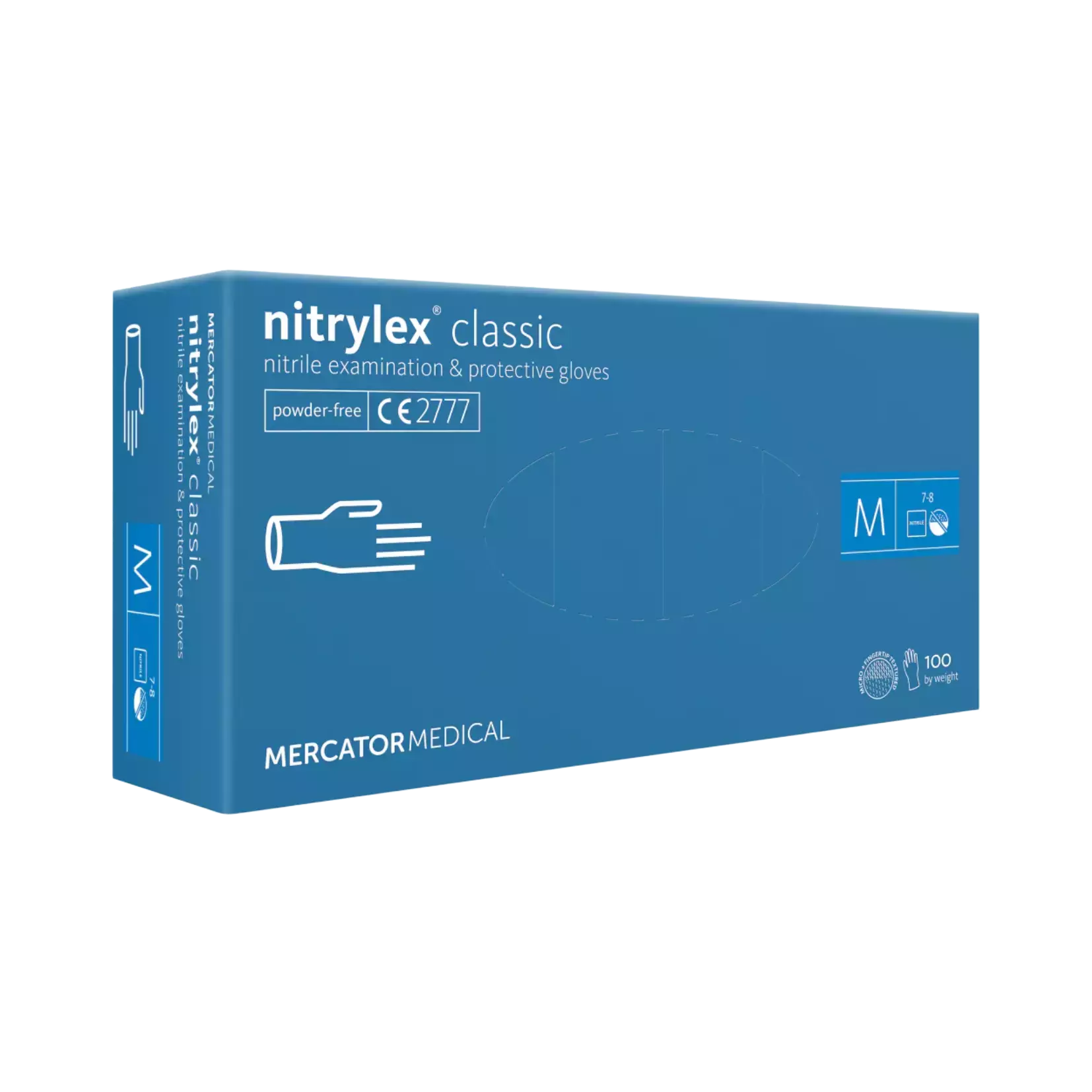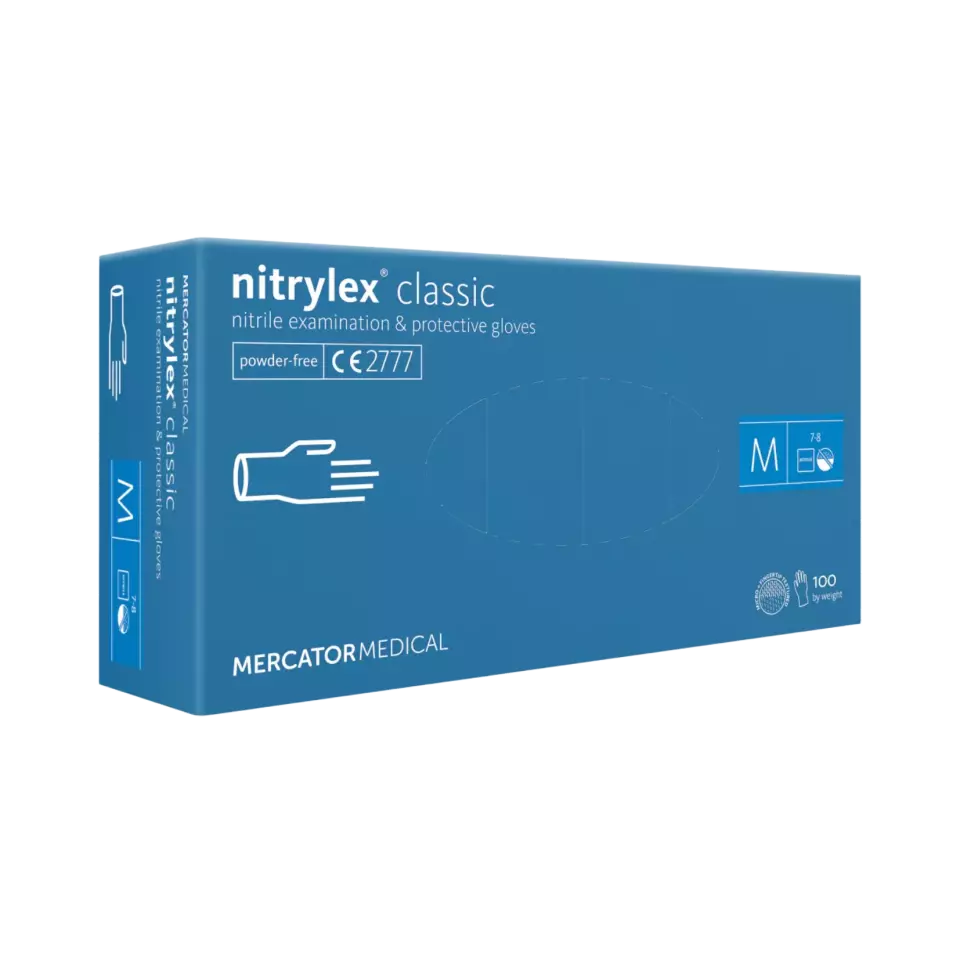
Mercator Nitrile Gloves
Mercator Nitrile Gloves
(20)


Features You'll Love

Fingertips · Textured
Describes the surface texture of the fingertip area, affecting grip strength and tactile sensitivity during use.
Describes the surface texture of the fingertip area, affecting grip strength and tactile sensitivity during use.
Describes the surface texture of the fingertip area, affecting grip strength and tactile sensitivity during use.

Cuff Style · Rolled
The design of the wrist opening, affecting ease of putting gloves on, comfort, and how securely they stay in place during use.
The design of the wrist opening, affecting ease of putting gloves on, comfort, and how securely they stay in place during use.
The design of the wrist opening, affecting ease of putting gloves on, comfort, and how securely they stay in place during use.
Mercator
Nitrile Gloves, 10 x 100 pcs
Nitrile Gloves, 10 x 100 pcs
(20)
33,86 €
Price per 10 packages (1 000 pcs)
3,39 € / 100 pcs
Free delivery
Features You'll Love

Fingertips · Textured
Describes the surface texture of the fingertip area, affecting grip strength and tactile sensitivity during use.
Describes the surface texture of the fingertip area, affecting grip strength and tactile sensitivity during use.
Describes the surface texture of the fingertip area, affecting grip strength and tactile sensitivity during use.

Cuff Style · Rolled
The design of the wrist opening, affecting ease of putting gloves on, comfort, and how securely they stay in place during use.
The design of the wrist opening, affecting ease of putting gloves on, comfort, and how securely they stay in place during use.
The design of the wrist opening, affecting ease of putting gloves on, comfort, and how securely they stay in place during use.
Product description
Mercator Nitrylex Classic engångshandske av nitril i ett paket om 100 stycken.
Slitstarka men tunna nitrilhandskar för precisionsarbete. Välsittande nitrilhandskar är lämpliga för användning inom hälso- och sjukvård, livsmedelsbearbetning och andra personliga skyddstillämpningar.
Mercator Nitrylex Classic engångshandske av nitril i ett paket om 100 stycken.
Slitstarka men tunna nitrilhandskar för precisionsarbete. Välsittande nitrilhandskar är lämpliga för användning inom hälso- och sjukvård, livsmedelsbearbetning och andra personliga skyddstillämpningar.
Mercator Nitrylex Classic engångshandske av nitril i ett paket om 100 stycken.
Slitstarka men tunna nitrilhandskar för precisionsarbete. Välsittande nitrilhandskar är lämpliga för användning inom hälso- och sjukvård, livsmedelsbearbetning och andra personliga skyddstillämpningar.
Measures how far the glove extends up the wrist and forearm, determining the level of coverage and protection provided during use.
Measures the material thickness at the palm area, affecting protection level and tactile sensitivity during use.
Indicates the maximum percentage of defective gloves acceptable in quality testing, with lower numbers representing higher quality standards.
Indicates how long gloves maintain their protective properties and quality when stored properly, typically measured in years from manufacture date.
Total mass of the glove package, useful for shipping calculations, storage planning, and comparing product quantities across different brands.
The design of the wrist opening, affecting ease of putting gloves on, comfort, and how securely they stay in place during use.
Describes the surface texture of the fingertip area, affecting grip strength and tactile sensitivity during use.
Indicates whether gloves contain powder on the interior surface to aid donning, affecting ease of use and contamination control requirements.
The texture of the glove exterior, affecting grip strength and handling capability for different tasks and working conditions.
The visual appearance of the glove material, ranging from basic colors to specialized options for different professional and aesthetic preferences.
The base substance used to manufacture the glove, affecting chemical resistance, durability, flexibility, and compatibility with specific applications.
Measures the thickness of the glove's wrist/forearm extension, affecting durability, tear resistance, and protection level during use.
Measures the material thickness at the fingertips, affecting tactile sensitivity, dexterity, and protection level during use.
Your go-to gloves for diverse tasks, offering reliable protection and convenience across many applications.
Provides comfortable, standard wrist-level protection for easy wear and removal during daily tasks.
- Food Service
- Medical Protection
- Hand Protection
Medical gloves with the EN 455-1:2020 rating are tested for freedom from holes using a water tightness test. This ensures the gloves provide a reliable barrier, protecting you from cross-contamination and the spread of infections.
Test results
This rating indicates the glove's quality and resistance to pinholes, which is tested by filling it with water. A lower AQL number means a lower chance of defects, providing a more reliable barrier against microorganisms.
Medical gloves with the EN 455-2:2009+A2:2013 rating are tested for their physical properties, such as dimensions and strength. This ensures consistent sizing and reliable performance, giving users confidence in their protection against cross-contamination during medical use.
Test results
This product is tested for physical strength and durability to ensure it provides an adequate level of protection from cross-contamination. It is designed to resist tearing and breaking during use, safeguarding both the user and the patient.
Medical gloves with the EN 455-3:2006 rating are tested for biological safety, including levels of latex proteins, chemical residues, endotoxins, and powder. This ensures the gloves are safe to use, reducing the risk of allergic reactions, irritation, or other adverse health effects for both users and patients.
Test results
This product is tested to ensure it is biologically safe, reducing the risk of allergic reactions and irritation from chemicals or latex proteins. It maintains its protective quality and safety for the specified years when stored properly.
Single-use medical gloves with the EN 455-4:2009 rating are tested for their shelf life, ensuring they maintain properties like strength and barrier integrity over time. This means the gloves will remain effective and safe, providing reliable protection against infections until their expiration date when stored correctly.
Protective gloves with the EN ISO 374-1:2016/A1:2018 rating are tested for resistance against dangerous chemical penetration, permeation, and degradation. This means the gloves are proven to protect your hands from hazardous substances and indicate how long they can withstand contact with specific chemicals.
Test results
This glove provides protection against chemical splashes, resisting permeation for at least 30 minutes for a minimum of three specific chemicals. It is suitable for tasks involving handling certain chemicals where moderate contact is expected.
Gloves with the EN 374-2:2014 rating are tested for their resistance to penetration, ensuring liquids and microorganisms do not leak through tiny holes or imperfections. This means the gloves provide an effective barrier, protecting your hands from direct contact with hazardous chemicals and microbes.
Test results
This product has passed a leak test to ensure it is a waterproof and effective barrier against liquids, bacteria, and fungi. This protects your hands from contact with harmful microorganisms in various work environments.
Protective gloves with the EN 374-4:2013 rating are tested for their resistance to degradation by chemicals. This measures changes in the glove material, like swelling or hardening, ensuring the glove maintains its protective qualities when exposed to hazardous substances.
Test results
This glove's material resists breaking down when in contact with specific chemicals. This helps protect you from physical changes to the glove like swelling, cracking, or softening that could compromise your safety during use.
Gloves with the EN 374-5:2016 rating are tested for resistance to penetration by bacteria and fungi, and potentially viruses. This means the gloves provide a protective barrier against microorganisms, helping to keep your hands safe from harmful biological agents.
Test results
This product protects you from bacteria and fungi. It passed leakage tests, making it a reliable barrier when handling materials where these micro-organisms are a risk, such as in cleaning or laboratory work.
This glove is tested to protect you from bacteria, fungi, and viruses. It provides a reliable barrier, having passed specific tests to ensure no leakage when exposed to these micro-organisms, making it suitable for handling contaminated materials.
Protective clothing, gloves, and footwear materials with the EN 16523-1:2015 rating are tested for resistance to permeation by hazardous liquid chemicals, specifically how long it takes for a chemical to pass through the material. This ensures the product provides a dependable barrier, offering a measurable level of safety when handling dangerous liquids.
Test results
This product’s material resists liquid chemical breakthrough. It is tested for how long it takes a chemical to move through the material on a molecular level, offering protection for a specified time during continuous contact.
Protective gloves with the EN 420:2003+A1:2009 rating are tested for general design, safe materials (innocuousness), water penetration, comfort, and dexterity. This ensures the gloves are safe, fit correctly, and allow you to perform tasks effectively without discomfort.
Medical devices with the ISO 13485:2016 rating are tested for a quality management system that ensures consistent safety, quality, and regulatory compliance throughout their lifecycle. This provides assurance that the product is reliably produced to high international standards for patient use.
Test results
This product was made under a quality management system that ensures consistent design, production, and distribution. This focuses on the safety, performance, and regulatory compliance of medical devices throughout their entire lifecycle, from design to disposal.
Food safe refers to the safety of food products that are used or consumed by people. In Europe, food safety is regulated by the European Union (EU) and the European Food Safety Authority (EFSA). These organizations set standards and requirements for food products to ensure they are safe to eat. To be considered "food safe" in Europe, a product must meet these standards and be free of harmful substances. This includes being free of harmful bacteria, pesticides, and other contaminants. Food products that do not meet these standards cannot be sold or used in the EU.
PPE stands for "personal protective equipment." PPE Category 3 refers to equipment that is complex and provide the highest level of protection such as powered respirators, SCBA, and full body suits. In Europe, PPE Category 3 must meet certain safety standards set by the European Union, which means that it must be designed and manufactured to protect the user without causing harm. Companies that make or sell PPE must prove that it meets these standards. They also must have a quality management system in place, have to be audited regularly by a notified body and have to have a technical documentation.
Free delivery for all Lacuna products